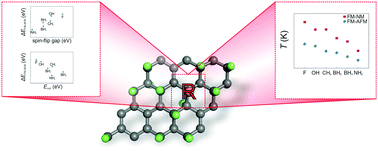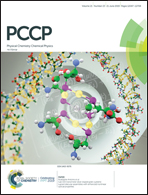Tuning the magnetic properties of graphene derivatives by functional group selection†
Abstract
The recent discovery of hydroxofluorographene G(OH)F, a graphene derivative showing room temperature antiferromagnetic ordering, suggests that there may be other sp-materials based on sp3-functionalized graphene that exhibit magnetic ordering. Here, we report a detailed theoretical study of hydroxofluorographene analogs, G(X)F, where X = –F, –SH, –NH2, –CH3, –BH3, and –BH2, conducted to deeper understand the relation among their structural, electronic and magnetic properties and to identify an effect of the functional group on magnetic transition temperatures. Although the magnetism of all G(X)F materials stems from the presence of aromatic islands with diradicals coupled via functional groups that enable superexchange interactions, the materials exhibited widely varying magnetic transition temperatures. The trends in the studied materials’ transition temperatures are discussed in relation to the widths of their spin–flip gaps and the materials’ stability. Our findings indicate that the properties of graphene-based magnets can be tuned by changing their functionalization, which may enable the design of organic magnets with tailored properties.



 Please wait while we load your content...
Please wait while we load your content...